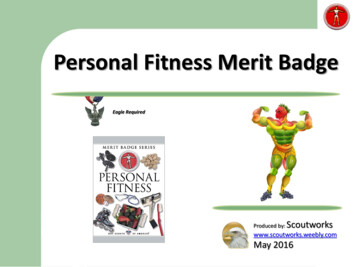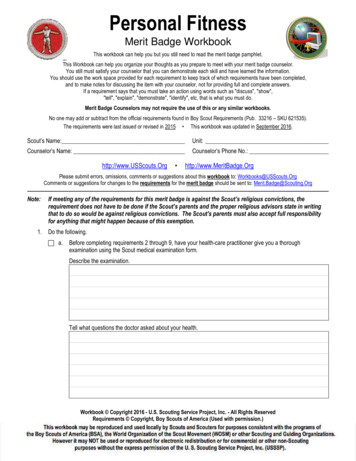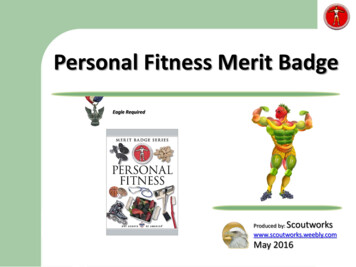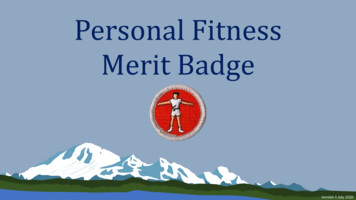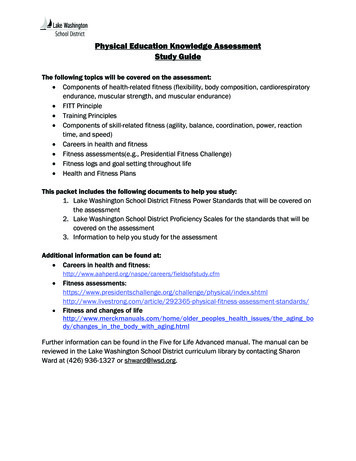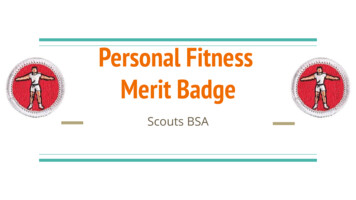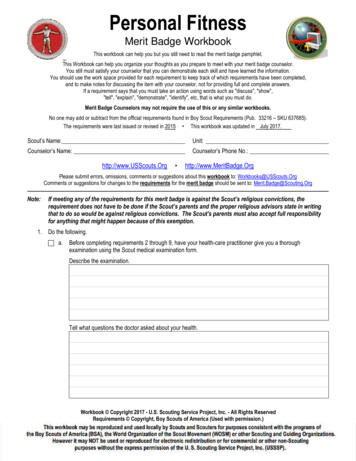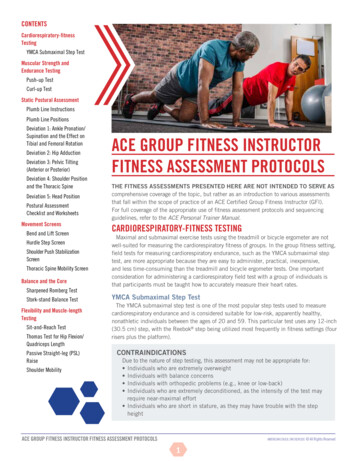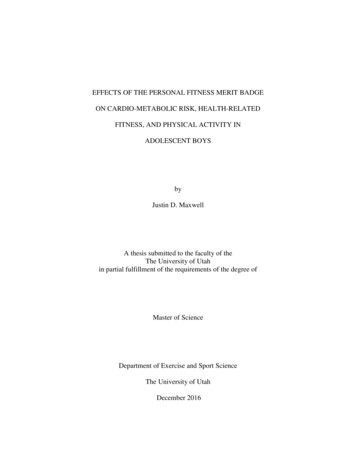
Transcription
EFFECTS OF THE PERSONAL FITNESS MERIT BADGEON CARDIO-METABOLIC RISK, HEALTH-RELATEDFITNESS, AND PHYSICAL ACTIVITY INADOLESCENT BOYSbyJustin D. MaxwellA thesis submitted to the faculty of theThe University of Utahin partial fulfillment of the requirements of the degree ofMaster of ScienceDepartment of Exercise and Sport ScienceThe University of UtahDecember 2016
Copyright Justin D. Maxwell 2016All Rights Reserved
UNIVERSITY OF UTAHSTATEMENT OF THESIS APPROVALThe thesis ofJustin D. Maxwellhas been approved by the following supervisory committee members:, ChairTimothy Brusseau9/9/2016Date Approved, MemberRyan Burns9/12/2016Date Approved, MemberHester Henderson9/12/2016Date Approvedand byTimothy Brusseauthe Department/College/School of, Chair/Dean ofExercise and Sport Scienceand by David B. Kieda, Dean of The Graduate School.
ABSTRACTA growing number of adolescents are more sedentary and are having fewer formalopportunities, such as physical education, to participate in physical activity. With themounting evidence that sedentary time has a negative impact on cardio-metabolicprofiles, health-related fitness, and physical activity, the need to find an affordableadolescent physical activity intervention that adolescents will participate in is paramount.The purpose of this research study was to evaluate the effect of the Personal Fitness meritbadge system on physical activity, health-related fitness, and cardio-metabolic bloodprofiles in Boy Scouts aged 11-17 years. Fourteen Boy Scouts from the Great Salt LakeCouncil of the Boy Scouts of America earned their Personal Fitness merit badge. Theresearch staff hosted one merit badge class held at a local church building in the SaltLake Valley. At the classes, boys received the information needed to obtain the meritbadge. They also had cardio-metabolic profiles taken using the Cholestech LDXanalyzer, performed health-related fitness testing, and received a pedometer to measurefree-living physical activity for 1 week. The boys completed the merit badge over 12weeks and returned to a final class to again be tested on the aforementioned measures.Results from the related-samples Wilcoxon signed rank test showed that the median ofdifferences between VO2 peak pretest and posttest scores were statistically significant(p 0.004). However, it also showed that the differences between the Pre-MetS and PostMetS scores (p 0.917), average steps taken per day (p 0.317), and BMI (p 0.419) werenot statistically significant. In conclusion, the merit badge had an impact on
cardiovascular endurance of the boys who earn the merit badge, suggesting this programhas potential to improve cardiovascular fitness and should be considered for boysparticipating in the Boy Scouts.iv
CONTENTSABSTRACT . iiiINTRODUCTION .1Study Significance .6Definition of Terms.7METHODS .8Procedures .11Data Analysis .12RESULTS .14DISCUSSION .19Limitations .22Future Research Directions .23CONCLUSION .24REFERENCES .25
INTRODUCTIONIn 2013, the Center for Disease Control and Prevention (CDC) reported that 15%of the United States adolescent population did not participate in at least 60 minutes ofphysical activity on any day of the week, that 33% watched television for 3 or more hoursper school day, and that 41% used computers for 3 or more hours per school day.Additionally, 52% of children and adolescents did not attend physical education (PE)classes in an average school week (CDC, 2013). These increases in sedentary time anddecreases in physical activity opportunities should be alarming for adolescents becausesedentary time has been associated with disease risk indicators such as obesity andcardio-metabolic health markers (Dunstan D.W., Howard, B., Healy, G.N., & Owen, N.,2012; Vaisto et al., 2014). It has been shown that poor metabolic scores may translatefrom adolescence to adulthood, which in turn increases the incidence of cardio-metabolicdisease and early mortality (Andersen & Haraldsdotter, 1993; Eisenmann, J.C., Welk,G.J., Ihemls, M., & Dollman, J., 2007; Katzmaryk et al., 2001).The question then becomes what can be done to improve the downward trend ofphysical activity? Obesity and overweight has been shown to be the most importantmodifiable factor in diabetes prevalence, thus decreasing the occurrence of obesity andoverweight becomes an important intervention in the prevention of diabetes (Menke, A.,Rust, K.F., Fradkin, J., Cheng, Y.J., & Cowie, C.C., 2014). It was found that Canadianshave much lower diabetes prevalence than Americans; one reason for this was thatphysical activity levels were higher in Canada than they were in the United States (Zhang
2et al., 2010). Those who were more sedentary had worse cardio-metabolic profiles whencompared to those who were more active (Dunstan et al., 2012). Thus, the need to findan effective, cost-efficient physical activity intervention in adolescences that decreasessedentary time is vital to the health of a growing number of American youth.Many physical activity interventions targeting adolescents have beenimplemented and evaluated. Alberga et al. (2013) evaluated 50 interventions and createda list of 10 practical ideas that will likely help improve the success of physical activityintervention. Physical activity setting is important, choice of trainer matters, physicalactivity should be varied and fun, parents-guardians should be included, individualphysical and psychosocial characteristics should be accounted for, realistic goals shouldbe set, regular reminders are important, multidisciplinary approach should be used,barriers should be identified early along with plans to overcome them, and participantsshould be told what is in it for them. It has also been noted that the longer theintervention lasts, the greater the health benefits and the higher the adherence to physicalactivity practices (Sun et al., 2013).The Middle School Physical Activity and Nutrition (M-SPAN) interventiontargeted middle school campuses before, during, and after school hours (Sallis et al.,2003). The goal was to change physical activity behaviors of the middle school students.To accomplish this task, the research staff aimed a portion of their intervention atphysical educators, community leaders and members, school leaders, parents, and schoolpolicies (Hoefer, McKenzie, Sallis, Marshall, & Conway, 2001; Mckenzie, 2000;McKenzie, 2001; McKenzie, 2004; McKenzie, Marshall, Sallis, & Conway, 2000;Moody et al., 2004; Sallis et al., 2001; Strelow et al., 2002). The intervention is regarded
3as one of the most successful school- and community-based adolescent interventions(Sparkpe, 2015). Physical education classes increased moderate to vigorous physicalactivity (MVPA) levels by 3 minutes per class (Mckenzie, 2000) and the students in theclasses were active for 52% of the class time, a 4% increase (Mckenzie, 2004). Thesesmall improvements helped significantly decrease the BMI of the participating boys(Sallis et al., 2003).A 12-week study examined an after-school program for boys and girls ages 5-12delivered by YMCA counselors. The program was created by an experienced team ofscholars who have vast experience with health behavior changes. Three days per week, a45-minutes class was held at the YMCA. Cardiovascular activities (e.g., jump roping,relay runs, adapted sport games, etc.) were used on all 3 days of the week; resistanceexercises (e.g., resistance bands, other exercises intended to strengthen major musclegroups) were utilized 2 out of the 3 days a week, and behavioral skill training (i.e., brieflessons on self-management and self-regulatory topics) was implemented once per week.The researchers found that this program could be used as an adequate replacement for thereductions of physical education in the school, probably because they found that byparticipating in the program, the participants had a significant reduction in percent bodyfat (Annesi, J.J, Westcott, W.L., Faigenbaum, A.D., & Unruh, J.L., 2005).Jago and Baranowski (2004) reviewed noncurricular interventions such as duringschool breaks, active travel, extracurricular activities, and summer day camps forpromoting physical activity. They found that, in general, these interventions showedlimited success. Many of the interventions failed to increase physical activity, reduceBMI, or change physical activity behaviors. It was suggested by the researchers that these
4interventions could have been improved if they had actively involved parents, focused onsetting appropriate goals, advertised the interventions to the potential participants moreeffectively, and exposed the participants to the intervention for a longer period of time.The interventions that the researchers in this study found to be successful saw increasesin habitual physical activity, short-term reduction in weight, and long-term weightcontrol.The Boy Scouts of America (BSA) is a values-based organization that focuses onthe development of youth character through a variety of avenues, including personalfitness (BSA, 2015). The typical ages for boys participating in the scouting program areages 11 to 17. The biggest accomplishment for a Boy Scout is to earn their Eagle Scoutaward. This task takes years to accomplish and requires the dedication of each scout toearn all the badges required. The Personal Fitness merit badge is one of 12 merit badgesrequired to earn the Eagle Scout award. In 2013, there were 888,947 Boy Scouts in theUnited States; 56,841 earned their Eagle Scout award and 56,295 of them earned theirPersonal Fitness merit badge, making it the ninth most common merit badge earned byBoy Scouts (BSA, 2015). To date, there have only been two studies published that haveused the Boy Scouts as participants in physical activity interventions.The first study examined the effects of a physical activity intervention using trooptime and an online program targeting self-efficacy and preference change (Jago,Baranowski, et al., 2006). The research team was given 20 minutes of troop time to leada physical activity session focused on earning what the researchers called the “Fit forLife” badge; scouts were encouraged to take what they learned in this session and use itin their daily lives. The activity sessions had a cognitive component (teaching about an
5activity, healthy habit, or safety guidelines) and a psychomotor component (opportunitiesto practice/play games that could be used outside of their troop meetings). Activitiesincluded stretching for basketball, ultimate football, strengthening for football, andbasketball knockout. Then, two times before the next troop meeting 1 week later, scoutswere asked to login to the online program and set goals and then report back on the goals.To measure if the intervention had an effect on body composition (BMI and skin foldthickness) and physical activity (scouts wore an accelerometer for 3 consecutive days),pretest and posttest measurements were taken. Although the intervention did not yield asignificant increase in minutes of moderate to vigorous physical activity (MVPA), therewas a trend toward decreasing sedentary time.Another study involving Boy Scouts evaluated the relationship between goalsetting and physical activity behavior change (Latif et al., 2011). The Boy Scouts wouldlogin to a program each week and set PA goals. Later that week, they would again loginand state whether they had completed that goal. To monitor physical activity levels, anaccelerometer was worn for 3 consecutive days. The results showed that physical activitygoals of the Boy Scouts did not relate to physical activity because the activity levels asmeasured by the accelerometer did not have significant change (Latif et al., 2011). Theresearch team of Seger, Eccles, and Richardson (2008) recommended that future goalsshould focus on outcomes to be achieved from physical activities goals, as this has beenshown to help relate goal setting to physical activity behavior change. The results fromthe aforementioned interventions have shown that both in school and out of schoolprograms can have a positive impact on the fitness and health of adolescents participatingin them. However, many of the interventions did not change physical activity levels,
6increase health-related fitness, nor did they improve cardio-metabolic profiles. Thepurpose of this research study was to evaluate the effects of the Personal Fitness meritbadge system on physical activity, health-related fitness, and cardio-metabolic bloodprofiles in Boy Scouts aged 11-17 years.R1: What effects will the Physical Fitness merit badge have on the physical activitylevels of Boy Scouts?H1: Boy Scouts’ physical activity levels as measured with the pedometer will show asignificant increase following the earning of the Physical Fitness merit badgeR2: What effects will the Physical Fitness merit badge have on health-related fitnesslevels of the Boy Scouts?H2: Boy Scouts’ health-related fitness levels for cardiovascular endurance as measuredby the PACER will show a significant increase in laps following the earning of thePhysical Fitness merit badge.R3: What effects will the Physical Fitness merit badge have on the cardio-metabolicprofiles of Boy Scouts?H3: Boy Scouts’ cardio-metabolic profiles will become more healthy as measured by asignificant reduction in BMI, LDL, total cholesterol, waist circumference, fasting bloodglucose, and blood pressure along with significant increases in HDL.Study SignificanceThis study will help identify the strength of the Personal Fitness merit badge as aphysical activity intervention. Thousands of boys earn the merit badge each year and itsbenefits are not yet known. The Boy Scouts of America can use the results of this studyto see how effective the merit badge is at helping scouts develop healthy habits. It has
7the potential to show strengths and weaknesses of the badge and provide ideas for waysto improve. The merit badge has the potential to be used outside of the Boy Scouts ofAmerica. It could be used in physical education settings, gym settings, and evenpediatric settings. For example, the merit badge could be used as a semester-long projectin a physical education class.Definition of Terms Body Mass Index BMI High-Density Lipoprotein HDL Low-Density Lipoprotein LDL Stadiometer instrument used to measure height
METHODSParticipantsA convenience sample of 14 Boy Scouts ages 11 to 17 years old (M 11.93,SD 1.21) from the Great Salt Lake Council of the Boy Scouts of America (Salt LakeCounty, Utah) participated in a Personal Fitness merit badge class. The class was held ata local LDS church building in South Salt Lake City. Boys came from the surroundingareas, including South Salt Lake, Murray, and Holladay. Boys who participated couldnot have earned the merit badge previously.Personal Fitness Merit BadgeThe Personal Fitness merit badge is one of 12 merit badges required to earn the EagleScout award. In order to earn the merit badge, scouts are required to complete nineintensive steps to improve areas of personal fitness. At the completion of the meritbadge, each scout will have performed the following: Visit a pediatrician or family practice doctor to have a physical Provide a detailed definition of and explain the importance of:o Mental healtho Physical healtho Social healtho Physical fitnesso Nutrition
9 Identify and learn the importance of the scout’s:o Weight and body compositiono Healthy and nonhealthy habitso Appropriate and inappropriate dietso Vaccination needso Sleep scheduleo Physical activity and exercise routineso Family lifeo Disease potential Perform pre- and posttest measurements for aerobic fitness (mile run), strength(pushups and curl-ups), flexibility (sit and reach), and body composition (BMI). Create, perform, and log a 12-week physical fitness program Find out about three careers that specifically deal with personal fitnessInstrumentsPhysical activity measurement. To objectively review the physical activity levelsof the participants, a Digiwalker CW600 pedometer will be utilized. The DigiwalkerCW600 has been found to provide a valid measure of physical activity in adolescents(Jago et al., 2006). As the scout left the merit badge class, they were given a pedometerto wear for 6 consecutive days, from the time they wake up until they go to bed, startingthe next day.Cardio-metabolic health markers. The cardio-metabolic profile of eachparticipant was collected using the Cholestech LDX system (Alere Inc., Waltham, MA,USA). The system included measures for total cholesterol (TC), LDL cholesterol, HDL
10cholesterol, triglycerides (TRI), and blood glucose (BG). The blood sample was collectedin a fasting state on the day of the merit badge class. Both the participant and the parentor guardian was asked for verification of the fasting state. Blood samples were collectedwith a single prick to the scout’s right index finger using a 40-uL capillary tube andimmediately injected into the Lipid Profile-Glucose Cassette (Alere Inc., Waltham, MA,USA) and subsequently analyzed. The finger was cleansed and bandaged and allmaterials were properly disposed of in a biohazard container.Blood pressure measures were identified by using the electronic blood pressuremachine the CONTEC08A (Contec Medical Systems Co.; Qinhuangdao, China). Toensure a resting measure, scouts had their blood pressure measured prior to performingany fitness testing. Blood pressure standards in adolescences are dependent upon age,sex, and height and are found in standardized charts (National Heart, Lung, and BloodInstitute, 2004; Riley & Bluhm, 2012). Prehypertension in adolescence is defined ashaving a blood pressure between the 90th percentile and the 95th percentile or having ameasure of 120/80 mm HG or greater. Hypertension is defined as having a bloodpressure measure greater than the 95th percentile (Riley & Bluhm, 2012).Body composition measurement. The Body Mass Index (BMI) of the participantswas used to measure body composition. BMI was found by taking the scout’s weight inkilograms divided by the square root of his height in meters. Height was measured to thenearest 0.01 meter using a portable stadiometer (Seca 213; Hanover, MD, USA). Weightwas measured to the nearest 0.1 kilogram using a portable medical scale (BD-590;Tokyo, Japan).
11Waist circumference was measured to the nearest 1cm using a standard tapemeasure. Height, weight, and waist circumference measures were collected in a privateroom. Shoes were removed, but the clothes remained on for all three measures.Aerobic fitness. Aerobic fitness was measured through the completion of theFITNESSGRAM Progressive Aerobic Cardiovascular Endurance Run (PACER).Participants completed as many PACER laps as possible. Scores were recorded to thenearest lap. The running took place inside of a gymnasium with hard wood flooring.The fitness testing and cardio-metabolic profiles for the pretest were collected onthe day of the first merit badge class. Posttest data were collected 12-weeks later at thelast merit badge class. The reason we did not use pushups, sit-ups, and sit and reach asdependent variables was because those tests have been shown to not have as strong of arelationship to health.ProceduresThe Great Salt Lake Council notified scout troops via email and face-to-facemeetings to ensure that each individual scout troop was aware of the day of the class.Scouts’ wishing to earn their Personal Fitness merit badge were asked be a part of theintervention group.Boys that did not want to earn their Personal Fitness merit badge, but who wishedto receive a free health screening, which includes health related-fitness scores, bloodpressure, BMI, waist circumference, blood lipid levels, and physical activity levels,participated in the control group. They too attended the merit badge class to receive thescreening; however, they did not receive any information about nor did they work on thepersonal fitness merit badge.
12The first class introduced the participant’s to the Personal Fitness merit badge andestablished what is required to earn the badge. Participants were tested on the PACER,pushups, curl-ups, and flexibility (sit and reach). The height, weight, and waistcircumference of each scout was gathered in a private room. The resting blood pressureand a blood lipid finger prick were also taken. As the participants left the first meritbadge class, they were given a Digiwalker CW600 pedometer to wear for 6 consecutivedays (starting on the Sunday following the class), excluding showering, swimming, oranother activity that could damage the pedometer if worn. At the completion of the 6days, participants met again at the location of the merit badge class to turn in theirpedometers to the researcher. Also, after the first class, the participants started workingon the completion of their individual Personal Fitness merit badges or went about theirnormal lives if they were in the control group. The participants did not meet with theresearch team again until the Personal Fitness merit badge was completed 12-weeks later.At the completion of the 12-weeks, the scouts returned for the last class where they wereagain tested and measured. If they have completed the merit badge requirements, theprincipal investigator signed off that the Personal Fitness merit badge had been earned.Again, as the participants left, they were given a Digiwalker CW600 to wear for 6 moredays (beginning on the Sunday after the class). Once the pedometers had been returned,the intervention was completed.Data AnalysisNormal distributions were examined using histograms and the Shapiro-Wilk test.Outliers were identified using box-plots and z-scores. Because of the small sample size,a nonparametric Wilcoxon Signed Rank test was employed to examine the median
13differences from pretest to posttest on all dependent variables. The first dependentvariable was a Metabolic Syndrome score (MetS), which is a clustering of biomarkersand has been associated with adolescent fatness (Eisenmann, 2007). The MetS score wascalculated by converting each cardio-metabolic health marker (i.e., HDL cholesterol,triglycerides, blood glucose, mean arterial pressure, and waist circumference) into a zscore. Because HDL cholesterol is inversely related to health risk, the z-score for thisparameter was multiplied by -1. The MetS score used for analysis was the sum of zscores. The second dependent variable was aerobic capacity as measured using thePACER test and a linear regression equation to estimate VO2 peak, which is currentlyused by FITNESSGRAM testing battery. The last dependent variable was BMI. Allanalyses had an initial alpha level of, p 0.05 and were carried out using the SPSS v21.0statistical software package (Armonk, NY, USA).
RESULTSThe related-samples Wilcoxon signed rank test showed that the median ofdifferences between VO2 peak pretest and posttest scores were statistically significant(p 0.004). However, it also showed that the differences between the Pre-MetS and PostMetS scores were not statistically significant (p 0.917). The differences of average stepstaken per day in the pretest and posttest were not statistically significant (p 0.317).Additionally, the differences of pretest BMI to posttest BMI scores were not statisticallysignificant (p 0.419). Data were also collected from convenience sample of 6 controlparticipants with the mean age 15.8 (SD 1.83); however, the sample was not largeenough to perform comparative statistics. The related-samples Wilcoxon signed rank testshowed that the median of differences between VO2 peak pretest and posttest scores forthe control group were not statistically significant (p 1.000). The difference of Pre-BMIand Post-BMI for the control group were not statistically significant (p .102). Lastly,the difference of Pre-MetS and Post-MetS for the control group were not statisticallysignificant (p .600). Descriptive statistics for both the experimental and control groupsare found in Table 1. The median differences from pretest to posttest for all dependentvariables are presented in Figures 1-3.
15Table 1: Descriptive Statistics for Experimental and Control GroupsExperimentalNMeanStandardDeviationControl 5263.5861.902.31Post-MetS15-1.143.1461.622.70
16Figure 1: Median Difference Between Pre-MetS and Post-MetS
17Figure 2: Median Difference Between Pre-VO2 Peak and Post-VO2 Peak; Statisticallysignificant p .0004
18Figure 3: Median Difference Between Pre-BMI and Post-BMI
DISCUSSIONThe purpose of this research study was to evaluate the effects of the Personal Fitnessmerit badge system on physical activity, health-related fitness, and cardio-metabolicblood profiles in Boy Scouts aged 11-17 years. The results showed that only VO2 peak ofhealth-related fitness saw significant change from the beginning of the 3-month meritbadge intervention period to the end of the intervention period (see Figure 2).This is an important finding as the professionals at the National Association forSport and Physical Education (NASPE) have said that the VO2 peak is the mostimportant element of health-related fitness because of its positive link to cardio-metabolichealth (NASPE, 2011).One reason for this significant change could be because the Physical Fitness meritbadge focuses on running as part of the scouts personal fitness plan. Scouts are asked toset specific goals to improve their running times and many times throughout the 12weeks, they are asked to check for improvement.Eisemann, Laurson, and Welk (2011) determined that the average or 50th percentileVO2 peak for an adolescent boy ranges from 42-46 mL/kg/min depending on age. Whenthe participants began the merit badge, they too had an average adolescent VO2 peak;however, by merit badges’ end, they had increased their VO2 peak closer to the 75thpercentile of adolescent boys – 49.9 mL/kg/min.It is also recognized that the change found in VO2 peak from the pretest to theposttest could have simply been from the participants having natural maturation growth.
20Thus, the results were not due to the merit badge, but to the participants getting morephysically mature. However, that much maturation in 12 weeks is not as likely. Theyalso could have taken the PACER test in physical education class at school, thus enablingthem to better know what to expect from the test and better perform the test because ofgreater opportunities to practice.The results showed that there was not a significant change between the pre- and posttest for MetS scores. One possible reason for this could be because the interventionperiod of 3 months was not long enough. Another study similar to this one also found thatthere was no significant change in the cardio-metabolic profiles of its interventionparticipants and it too was 12-weeks long (Harrington et al., 2015). Some studies haveshown that physical activity interventions like the merit badge have improved metabolicprofiles; however, they were all longer than 3 months (Beavers, Beavers, Lyles, &Nicklas, 2012; Cui, Trusedale, Bradshaw, Cai, & Stevens, 2015; Kujala et al., 2011). Ifwe were to see changes in metabolic profiles, the merit badge would have to be closer toa year in length, which is probably feasible for the Boy Scouts of America.Similar to the lack of change in the MetS score, there was no significant difference inBMI from pretest to posttest. Again, one reason could be because the intervention periodwas not long enough. The MSPAN study, which had a total of 33 months (21 monthslonger than this study), found significant change in BMI over time (Sallis et al., 2003),providing evidence that a longer physical activity intervention can have an effect on BMI.Another reason for the lack of change in BMI could be because it has been found thatBMI changes are stronger in overweight populations (Berkey, Rockett, Gillman, &
21Colditz, 2003) and this cohort of scouts had an average BMI of 19, falling in the CDChealthy weight category (CDC, 2015).Another reason for the lack of changes in MetS scores and BMI could be because themerit badge has a focus on physical activity, but there is little emphasis placed uponnutrition. What the scouts eat can be just as important as the activity they areparticipating in on a daily basis.All scouts should be encouraged to participate and earn the Personal Fitness meritb
The purpose of this research study was to evaluate the effect of the Personal Fitness merit badge system on physical activity, health-related fitness, and cardio-metabolic blood profiles in Boy Scouts aged 11-17 years. Fourteen Boy Scouts from the Great Salt Lake Council of the Boy Scouts of America earned their Personal Fitness merit badge. The

